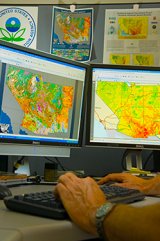Data Management

Following a contamination incident, remediation is required to protect human health and the environment. All data associated with environmental sampling and analysis activities throughout remediation will need to be maintained and checked for quality to advise decision-making. Data management frameworks are developed to support the data management process and include tools, technologies, and processes to plan, collect, store, retrieve, visualize and distribute data.
Examples include:
- Scribe – Scribe is a software tool developed by EPA’s Environmental Response Team (ERT) to assist in the process of managing environmental data. Scribe captures sampling, observational and monitoring field data.
- Tools Used for Visualizing Sampling and Analysis Data During Response to a Contamination Incident – This report describes research conducted to identify commonalities, efficiencies, lessons learned, and gaps among data visualization and statistical analysis tools currently used throughout EPA and the federal government. The research emphasized tools used to visualize data collected in support of remediation after a contamination incident to streamline and improve the capabilities of United States Coast Guard (USCG) and EPA responders. The research built upon a previous effort to identify and recommend user-friendly tools that facilitate the acquisition and subsequent management of field sampling data.
- Data Management for Wide-area Responses: Literature Review and Operational Expert Feedback – In the event of a wide-area contamination incident, EPA is responsible for site clearance, waste disposal, and data collection and quality checks to advise decision-making. This research effort aimed to identify and recommend user-friendly tools that more easily facilitate the acquisition and subsequent management of field sampling data to streamline and improve the capabilities of USCG and EPA responders.
- Data Management for Wide-area Responses: Technology Evaluation and Operational Expert Feedback – Following a wide-area contamination incident, from initial site characterization through clearance and waste disposal processes, a substantial amount of data will be collected, checked for quality, and maintained to support decision-making. Depending on the size and scope of the contamination, data management could result in a significant undertaking that could continue for many years. Tools and technologies that might be used include computers or tablets, software applications, mobile devices, databases, data models, (GIS) applications, laboratory reporting tools, and auxiliary tools such as GPS. Understanding the capabilities of these tools and technologies is critical to advancing the Department of Homeland Security’s (DHS’s) and EPA’s data management capabilities. Integrating a suite of technologies to support a comprehensive data management framework is necessary to effectively organize, document, quality assure, and communicate data.
